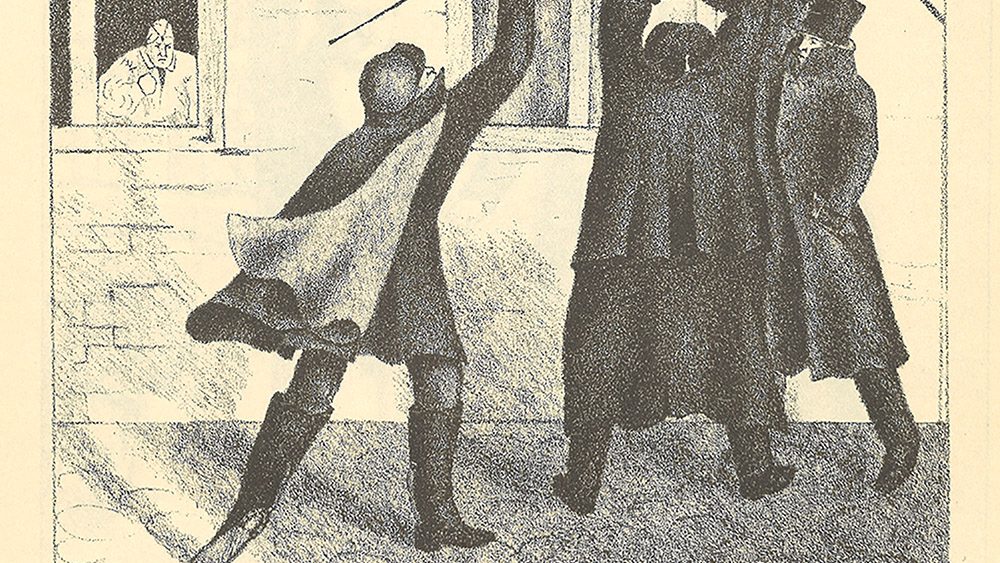Image: Agitated students on their way to crush windows under the slogan “pereat”, Latin for “may he vanish”. Lithograph by the Lund student C.G.W. Carleman from the 1840s. Source: privately owned.
Did you miss part 1?
Read it here
Achatius Kahl, a well-known chronicler of academic Lund in the early 1800s, has recounted that “each semester in the lock-up, the students’ jail cell […] sat several of the noisiest and most unruly for long or short periods”. It is evidence that indicates a rise in “unruliness” compared with the preceding, much calmer 1700s, when the lock-up could instead be used as a storage facility for building materials. That the students’ nightly drunken escapades were on the rise again is also hinted at in a decision from the spring semester of 1812, which completely prohibited students from being out after nine in the evening. If you were found in a tavern after this time you would “without mercy” be “taken into custody and according to the law confined in the lock-up”.
However, it was not just isolated incidents of “night disturbances” that increased around 1800. The students of these times also displayed tendencies to band together to cause trouble for more principled and ideological reasons. As early as 1793, one hundred or so angry students went on the attack against a private ball, mainly attended by aristocratic officers, sang malicious songs against the “the noble bastards” and smashed windows until one of those present, a lieutenant who was considered to have insulted the students earlier that day, was forced to come out and apologise. As the French Revolution had cast a long shadow, this incident also sent a frisson of fear through the powers that be in Stockholm. The government intervened and overrode the University’s own jurisdiction in the subsequent trial, although all the accused were finally acquitted. The riot in question was probably less to do with actual radicalism than with the students sulking about not being invited to the party. Even so, it can be seen as a sign of the beginning of a new collective “united spirit” within the student body which, when there was dissatisfaction, could sometimes lead to violent consequences. Manifestly physical demonstrations occurred, for example, in 1802 following an unwanted and heavy-handed felling of trees in Lundagård, and in 1837 following a decision to demolish the wall around the same park. In the first case, students placed all the cut-down branches and trunks outside the then vice-chancellor’s residence, blocking the door. In the latter case, stones were thrown at the bishop’s window – and hit his head (but without serious injury). However, in neither case did students seem to have been detained in the lock-up for what happened. In 1802, there was no punishment at all, and in 1837 there were more serious consequences than being temporarily put in the cell: a number of those involved were expelled.
Overall, it seems the lock-up had again entered a period of reduced usage when we come to the 1820s. In any case, a note in Consistory minutes from December 1823 can be interpreted as the “Lock-up room” at that point not having been used for a good while. This can be inferred from the fact that the room “will soon be utilised” leading to an order to the University’s treasurer to “take care of its repair, in particular that a new, strong door is acquired thereto”. But where was this room that was being prepared in 1823?
The elusive lock-up period
It was mentioned in part 1 of this article that, as early as the 1730s, the University and the City of Lund had discussed cooperation on joint detention premises. At that time, it had not resulted in anything concrete, but in 1794 there was a new attempt. The University then committed “to share half the costs with the city” to establish “a necessary room for the night watchmen” – which the city and University jointly staffed – “as well as a better and more secure detention facility for the imprisonment of debtors or those sentenced to prison as well as for prisoners and malefactors”. This would all be housed in an existing building in front of the cathedral and next to the Cathedral School’s then premises. As mentioned in part 1, according to K Arne Blom it was in this joint municipal-academic confinement facility that the murderer Blomdahl was placed after the “murder at Locus Peccatorum (the House of Sin)” in 1829. This was a possibility, because William Karlsson’s history of Lund’s police force in olden times states that the building in question was demolished in 1838 (after a petition from the church, which found it “a blot on the city”). The same book also indicates, however, that the period in which the premises were shared by the city and University was quite short, and that by 1802 it had been converted into a dedicated city jail.

demolished in 1897. Source: Academic Society Archive & Student Museum.
At the same time, the University had erected a new building, mainly for its central management and administration but also to accommodate several lecture halls and space for different scientific collections. The building – officially called the “New Academy” but which the students referred to as “Kuggis” – was sited as a wing of the King’s House on the eastern side. According to information that appears in various summaries, a new lock-up would have been set up in this building, and it is where Kjell Åke Modéer places Blomdahl in 1829.
But was there actually a lock-up at the New Academy? If you look at the original plans for the building – in which the function of each room is stated in detail – there are no such premises on the plan. According to a diligent local and University historian, the curator of the University’s Zoological Museum, Yngve Löwegren, who published a book on the history of the New Academy in 1963, there was a lock-up: initially on the upper floor and later moved down to the former “beadle chamber” (staff room for the University’s caretakers) on the ground floor. Regarding the original location, Löwegren refers to a paragraph in Consistory minutes from 1799, whereas the later location has no stated source whatsoever. However, when the relevant paragraph in the minutes was checked, it was shown that there is no mention at all of the lock-up, and I have not found any information about this in other written primary documents I have studied. There is, however, a preserved plan of the New Academy on which someone, probably on behalf of the Consistory, has drawn in red pen diverse suggestions for changes to the floor plan, and here the word “Proba” (lock-up) can be found written on a room on the upper floor, which had originally been earmarked as “treasury”.
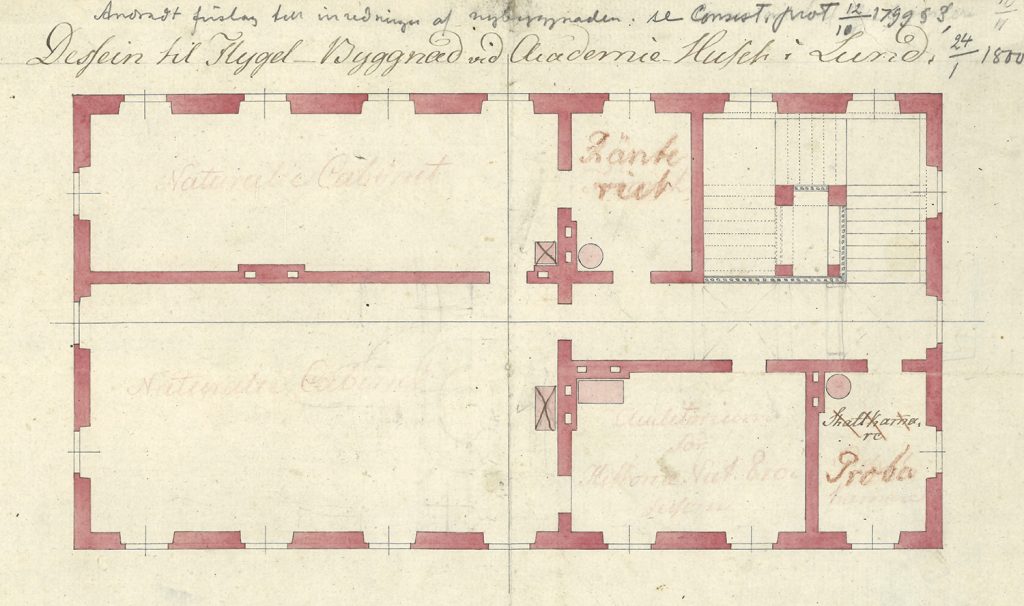
including the establishment of a lock-up in the lower right corner. Source: Lund University Archives.
Was the proposed change ever implemented? Personally, I am doubtful that it ever actually happened. One reason for this suspicion is an inventory of the University’s total building portfolio from 1833. This counts a number of rooms and functions in the “New Academy Building”, but nothing is stated about a lock-up. On the other hand, further on in the inventory is a mention of the “the current fencing hall with second storage room (also called detention room)”. This indicates that in 1833 the lock-up was still located adjacent to the University’s fencing hall, i.e. at Liberiet on Kraft Square, where it had been moved 70 years earlier. And the fact is that even Löwegren, writing on the professed detention premises at the New Academy, states that they have “[it seems] not been used very much”, but that “the old detention facility in the fencing hall building was probably used during the entire period”.
Based on a rather strong likelihood, I therefore maintain that the premises used to imprison Jacob Wilhelm Blomdahl in 1829 were located at Liberiet.
The shooting of student Haase
It is probable that “Student Lars Mathias Dahl” was also taken to the same cell in November 1838. This was after he had “confessed to firing a shot from which student C. J. Haase received a severe injury that endangered his life”. This shooting drama left a far fainter impression for posterity than Blomdahl’s murder of Andreas Emanuel Landén nine years earlier, and neither did it have a fatal outcome, but it did create just as great a splash in the press at the time and resulted in a legal process that was eventually resolved far above local academic jurisdiction. The background was that Dahl, a 17-year-old first-year student of the Skåne student nation, fired a shotgun at a fellow nation member, the three-year-older Carl Johan Haase, injuring him so badly that he lost the sight in both eyes. Dahl himself claimed that the shot was purely accidental, but rumours circulated in the press that the incident had “not been quite such an accident as one thought” but that instead it “was caused by the perpetrator’s love-related jealousy”. Of interest from the perspective of this article is that the latter information was said to stem from Dahl’s time in the lock-up:
It is said namely, among a number of other stories, that the same person [Dahl] had stated to the guard, who was on duty outside the door of his cell (he was held under arrest initially) that “it was so bloody peculiar that the shot hit his eyes, as I was only aiming for his nose,” (on which he, according to another statement, wanted to “score a bulls-eye”). The defendant’s lawyer, student Nerman, wanted to challenge the guard’s testimony on the grounds that it was “said in confidence.” However, the Consistory, which did not consider that anything confidential could occur between the person in question and the guard, let the testimony stand.
The period during which Dahl could have spoken to the guard in confidence would in any event have been short. According to what the vice-chancellor noted later, Dahl had been put in the lock-up on 30 November but had already “been released the following day”. The reason was that Dahl’s father, who by all accounts was a rather wealthy rural dean, had paid his son’s bail. The subsequent trial, which was held several months later (at a guess due to Haase’s state of health) was to be very much concerned with the claim for damages that Haase, who reportedly was the son of a “destitute” brewer and former artilleryman, could make against Dahl and his father. It would be too much to describe here the long-drawn out legal process in detail, which ended (to Dahl’s disadvantage) in the Supreme Court just over three years later. I will just state here that despite all the circumstances things turned out fairly well for Haase, who the whole time had the undivided sympathies of the student’s unions and the general public. As Haase had already become known for his musicality, the “Ladies of Lund” collected a total of 650 crowns to buy him a piano, among other things. Thanks to this, Haase could actually pursue a long professional career as a music teacher in Ystad. There he married and became a father to, among others, a son who in time became a student in Lund and, in contrast to his father, could complete an academic education (to become a physician).
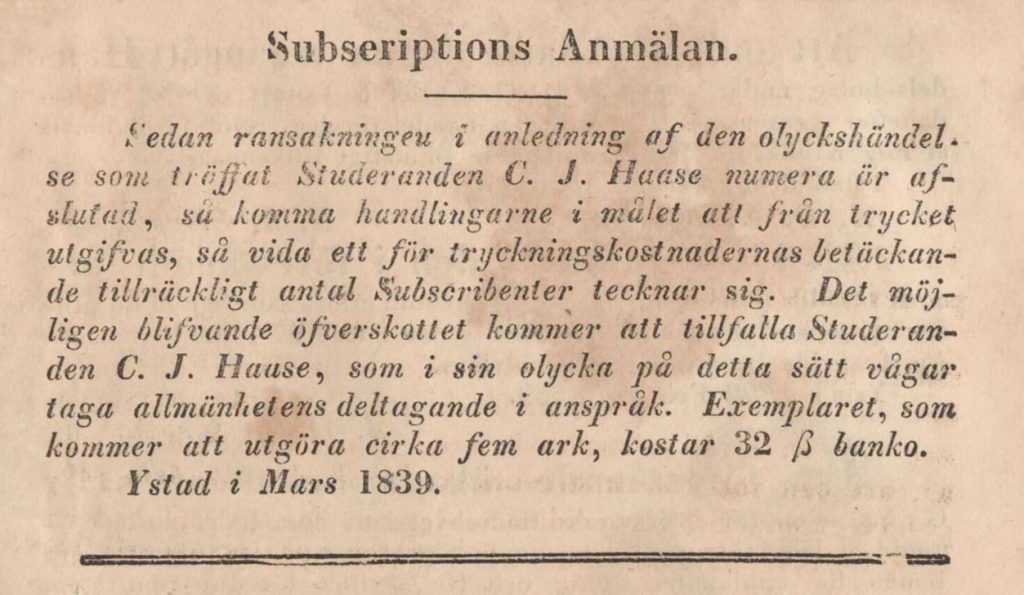
Among the skeletons in the attic or in the greenhouse building?
My theory that Dahl, even as late as 1838, was also placed in the lock-up at Liberiet is further strengthened by a couple of points in the Consistory’s minutes from November 1844. At that point, six years later, the story of this lock-up definitely ended, as Liberiet was to have a completely new function as rehearsal premises for the Academic Orchestra, and a detention facility was obviously not considered to fit in with these plans. The then vice-chancellor, mathematician Carl Johan Hill, told the Consistory that “as the Academy’s old fencing hall building, which up to now has housed the jail for people under academic jurisdiction, has now been refurbished for other purposes, the Academy is lacking its own detention facility for needs that may arise”. A new facility must therefore “be established as soon as possible”. After a short discussion, it was decided to situate the new lock-up in “the outer of the storage rooms in the Academy Building used to hold the Academy office’s papers” i.e the archive room where the University kept its financial documents. University caretaker Björklund was ordered in this connection to “place the iron bars from the old detention cell” in this room.
However, the matter was not resolved so easily, as only a week later the vice-chancellor was forced to raise the issue again in the Consistory. This was because, Lund’s bishop, who was at the time also acting chancellor of the University, had heard about the matter and considered that it was inappropriate to place the lock-up in a room on the ground floor of the Academy Building, which moreover faced Lundagård. Together with the professor of natural history, Sven Nilsson, the vice-chancellor had therefore inspected the upper floors of the Academy Building to see whether the detention facility could instead be established in “the attic over the room where the Department of Zoology’s collections are currently housed” and where diverse “animals and skeletons etc. are stored”. However, the two professors had come to different conclusions. While vice-chancellor Hill thought that the premises in question, a small room on the north gable side of the Academy Building was adequate, Nilsson was more than sceptical. Above all, he pointed out that the need for a fire to be lit in the previously unheated space “would entail a high risk of fire”. Hill stated that this problem could be solved by the caretaker “being responsible for supervision”, but Sven Nilsson was not to be swayed. Instead, he put forward a completely new proposal: “that the jail facility must be established at the corner of Sandgatan and Lazarettsgatan [probably where Paradisgatan is now], in the old greenhouse building belonging to the Department of Botany, which for a long time has not been used for its origin purpose but put at the disposal of the Department of Zoology”. As a result of this, the Consistory members adjourned for a while to go off and examine both premises “with their own eyes”. The inspection came out in favour of Nilsson’s proposal, and as professor of botany, Johan Wilhelm Zetterstedt, also stated that he had no objections, “the Consistory decided that the western part of the greenhouse building in question, which has a dedicated exit on Lazarettsgatan, is to be established as the Academic Jail”. Using wording that feels unmistakably urgent, it was also decided that work on the new lock-up would be carried out “as quickly as possible” but at the same time “with the lowest costs for the Academy”.
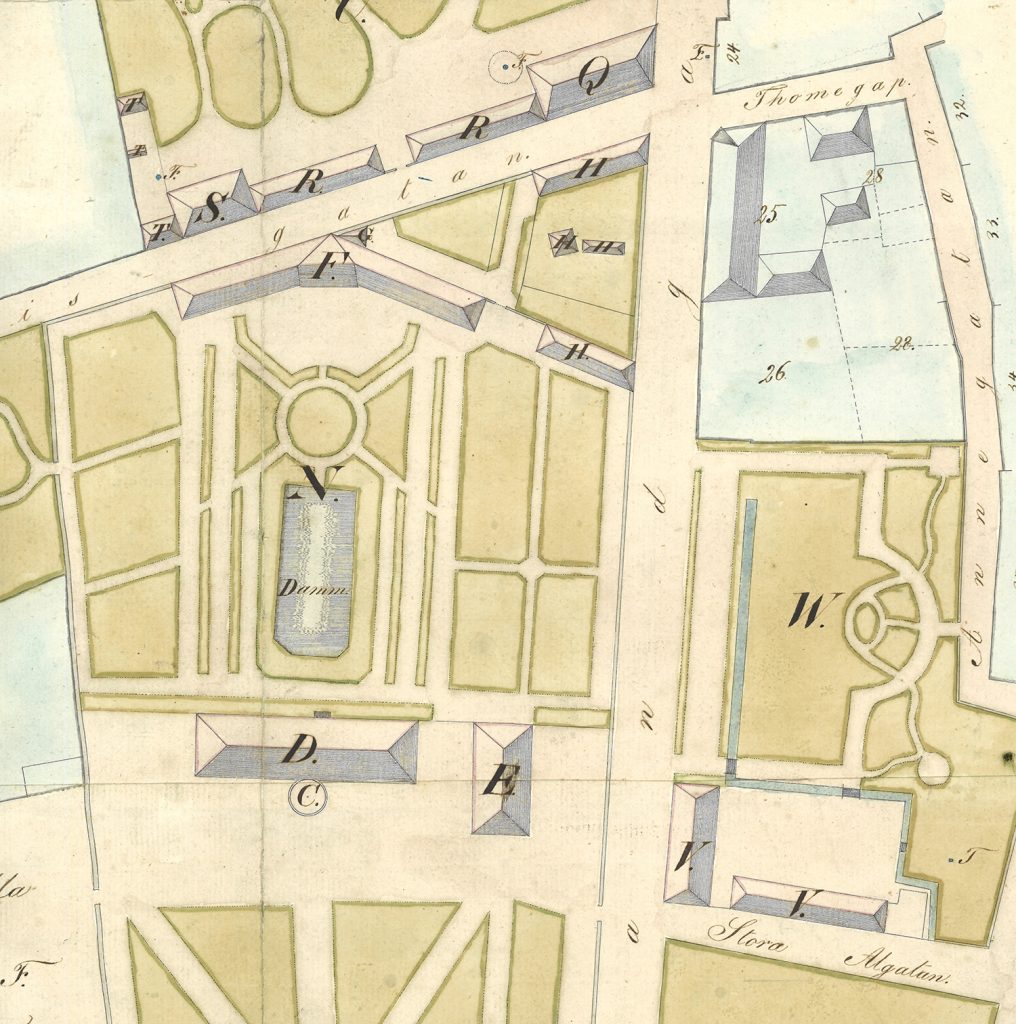
An archive preserved by chance
The discussion from 1844 referred to above is unique in that it is one of the very few instances in which I have been able to find the location of the lock-up discussed in detail and described in the University’s archive documents. Considering that this facility existed in some form or other for 184 of the, to date, 353 years of Lund University’s history, it can otherwise be stated in general that there are surprisingly few traces in the source material. Many of the information sources I have referred to above are to be found embedded here and there in general series of minutes, inventories and building plans, whereas specific archive series of the type “Documents concerning the lock-up” are conspicuous by their absence. In the University’s own archives that is. At the Regional Archives in Lund, part of the National Archives, there is, on the other hand, a very specific archive named “Lund Academy Jail archive”. What is it doing there and why hasn’t the University taken care of the archive? These are questions that naturally spring to mind for those who wish to see a degree of order.
The explanation is that this archive consists entirely of documents sent out by Lund University, more specifically monthly lists of those held in custody, which were compiled for the Court of Appeal for Skåne and Blekinge. The fact that these were preserved there is partly due to chance. Some of the documents – all folio sheets folded in two with writing only on one side – show clear signs that they have been folded inside out and then reused as covers for other documents before they were, in connection with a major weeding of documents at the Court of Appeal, finally and fortunately sent to the Regional Archives rather than just being discarded. It is impossible to say for sure whether there were originally more reports than those that have been preserved, but the fact that the archive begins in 1824 (whereas the Court of Appeal was established in 1821) and that certain months are missing in the earlier years, indicates that this is the case.
However, even with these reservations, the archive gives the only more general picture of the lock-up’s use in its final decades. It thereby clearly shows that as a rule during this period imprisonments were few and far between. Most of the reports consist of brief wordings in the style of this example from the autumn of 1825:
I hereby humbly notify that during the course of the past month of October no prisoner has arrived at Lund Academy Jail or been in detention there.
One year’s detention due to debt
However, there are a number of exceptions to this rule and through this we have an opportunity to get more closely acquainted with some of the lock-up’s very last internees. The murderer Blomdahl crops up in the records, of course, in connection with his trial in 1829, and the last night before his execution (in the meantime he had been held at the fortress prison in Malmö), as does the aforementioned Lars Mathias Dahl.
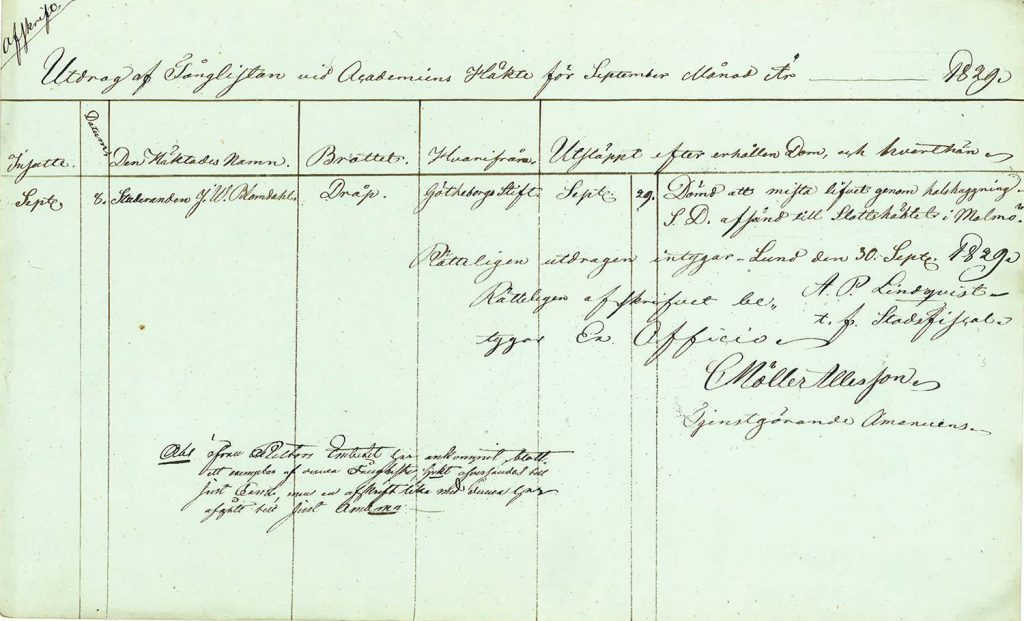
By all accounts, Dahl was the last to be held in the lock-up for something relating to life and limb or other serious crimes. However, it cannot be said that he was the last of all to be lock up there. The reports to the Court of Appeal note three further names of internees: Frans Rosengren, Anders Ahlgren and Knut Axel Dahlström. All were detained for long or short durations in the period 1845 to 1847, and thereby would probably have been the only ones to use the lock-up established by the Consistory in 1844 in the old greenhouse building on Sandgatan. However, none of them were held there because they had committed a crime, either against general laws or the University’s internal rules and regulations; rather they were imprisoned for debt. It was therefore the case that they owed money to one or more private individuals and had not been able to pay their debts. The creditors had the right to request that the guilty parties be locked up until they paid off the debts.
Opportunities to generate income while being held in the lock-up would probably have been very limited, so the expectation would have been rather that more solvent relatives or friends would come to the debtor’s rescue and pay up to release the person concerned. This seems to have been the case for Dahlström, as he was already released “after some hours has passed” in March 1847. It was worse for Rosengren who was locked up for the entire spring semester of 1845 and even worse for Ahlgren from Västergötland, who was imprisoned for an entire year – from October 1846 to October 1847. However, this was not the only thing that was long-drawn out in Anders Ahlgren’s student life. Together with his twin brother, Isak, he was one of the period’s well-known perpetual students. The two brothers spent 14 years in Lund “involved in philological studies, but without taking academic degrees”. Even though the brothers came from a “a respected and wealthy farming family” one can imagine that the resources they had eventually dried up during such a long period of studies, and that it was therefore not particularly odd that at least one of them ended up in the lock-up for unpaid debts. But was it actually just one of them who was imprisoned? The Ahlgren brothers were identical twins and it was difficult to tell them apart. This was the basis for a rumour, recounted here by the city bailiff Carl Sjöström in his biographical cadastral of the Västergötland student nation:
“There was one time in Lund when one of the brothers had been imprisoned for debt. The other one visited his imprisoned brother, swopped clothes with him and stayed there in his place. They switched in this way and consequently alternated their way through the misadventure. The parish vicar once asked Anders if this was true. He answered with a certain indignation: “Oh, certainly not; my brother Isak was far too conscientious for something like that.”
It is not stated in the documents that I found why Ahlgren was eventually released. Perhaps his debts had been paid in the end by another brother, the wealthy and childless Peter Ahlgren, who according to Sjöström would have been the twin brother’s meal ticket once they had used up their own shares of the patrimony. There is, however, another possible explanation. The person who had requested that someone should be imprisoned for debt had to pay for food and other costs during the period of imprisonment. After a year, did Ahlgren’s creditor perhaps feel that it was simply becoming a little too expensive to keep him locked up? In any case, Ahlgren was released, left Lund the same year and “then worked as a children’s teacher in his part of the country”.
After Anders Ahlgren, the lock-up probably stood unused – at least as a jail – for the period of just over five years that remained until the turn of the year 1852/53. This was when academic jurisdiction was abolished and with it the University’s obligation to maintain a detention facility. In January 1853, the then vice-chancellor, theologian Hans Magnus Melin, could consequently send in the very last – prisoner-free – custody report to the Court of Appeal.

1853. Source: National Archives (Lund Academy Jail archive).
Fredrik Tersmeden
Archivist at the University Archives (and unpunished to date)
Thank you to my archivist colleagues Henrik Ullstad and Mikael Falk who helped me to find biographical information on some of the students named in the article and to decipher certain old, difficult-to-read documents.

